The other day I bought soy milk for the first time in a long time.
I used to drink soy milk for a while because I thought it was good for me, but at some point it became my main source of milk again, and it may have been a year or so since I last drank it.
It may have been a year since I last drank soy milk, but when I saw unadjusted soy milk and prepared soy milk lined up side by side at the supermarket, it occurred to me.
I remembered that there were two of them….
 マッキー
マッキーWhich one is better for you?



Which is not fattening?



How are they different in the first place?
I knew there were unadjusted and prepared soy milk, and I had drunk both, but I actually drank them without really knowing the difference.
Since it was a good opportunity, I bought both and compared them to find out the difference. I am a little overweight these days, so I am also interested in which one is better for weight loss. (^_^;
Well…
The photo shows prepared soy milk on the left and unadjusted soy milk on the right.
First, there is the difference in appearance and the feeling of drinking.
Difference in color in appearance and taste in drinking
The following is a comparison of unadjusted soy milk/pre-prepared soy milk of Marusan Eye Co.
Aside from the color, the taste and drinkability of the two differ greatly depending on the individual. I thought the prepared soy milk tasted better and was easier to drink, but when I asked my wife to drink the same thing, she was surprised that she said the unadjusted soy milk tasted better and was easier to drink. (^_^;
Please understand that what follows is just my feeling.
Unadjusted soy milk
- Slightly darker cream color than adjusted soy milk
- Thick and slightly sludgy
- Not too thirst-quenching
- Tastes and smells like soybeans. Slightly bitter taste lingers in the mouth?
- No sweetness, not tasty enough to drink on its own
Prepared soy milk
- Pale cream color, almost white
- Light and smooth
- Light thirst-quenching and easy to drink
- Slightly sweet, reminiscent of milk
- No soybean taste
So what is the difference between the two in the first place?
What is the difference between unadjusted soy milk and prepared soy milk?
The JAS Law of the Ministry of Agriculture, Forestry and Fisheries of Japan defines it in detail, but in simple terms
Soybean solids content of 8% or more.Nothing is added other than soybeans.
Prepared soy milk
Soybean solids content of 6% or more. Only sugar (e.g. sugar), salt, and vegetable oil are added to make it palatable and flavorful.
The product is considered to be a “soybean milk”.
Soy solids is the component of the product from which water has been removed. In essence, it is the amount of soybeans used in the product.
The reason that prepared soy milk is somewhat thicker and has a stronger bean aroma is due to the difference in soybean solids content.
Naturally, unadjusted soy milk has more soy protein.
Let’s take a look at them individually.
Sector Comparison!
Which is better for weight loss?


Soy milk is one of the most effective beverages for reducing blood cholesterol and neutral fat, and is very good for those who are concerned about their diet.
So, furthermore, which is more diet-friendly, unadjusted soy milk or prepared soy milk?
In addition to Marusan-Eye’s, I also bought Kikkoman’s soy milk to find out.
Marusan’ai’s product has 103 kcal per 200 ml of unadjusted soy milk and 109 kcal per 200 ml of prepared soy milk; Kikkoman’s unadjusted soy milk has 115 kcal per 200 ml and prepared soy milk has 117 kcal per 200 ml; unadjusted soy milk is slightly lower in calories.
Cholesterol is a tie at 0 for both.
Carbohydrates are slightly higher for the adjusted soy milk.
So for dieting, the low-calorie unadjusted soy milk is slightly better.
Which is healthier?
The following table compares the nutritional content of unadjusted soy milk and prepared soy milk. The reference is to the product I bought from Marusan-Eye Co. I also checked Kikkoman’s product, and while the figures differ slightly, the overall trend is the same.
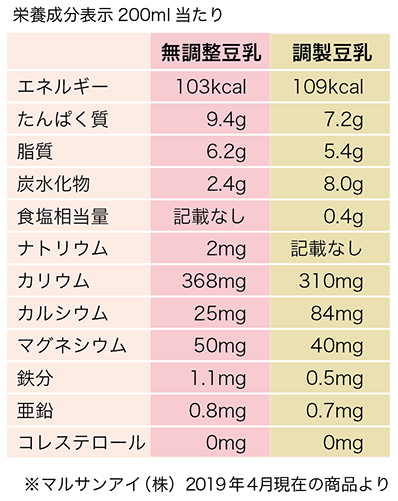

As you can see from the table, calcium is higher in prepared soy milk, iron, magnesium, and potassium are higher in unadjusted soy milk, and fat is higher in unadjusted soy milk.
Iron is associated with anemia, magnesium with bone and blood pressure maintenance, and potassium with muscle and hypersensitivity, so those who are concerned about these issues have a slight advantage with unadjusted soy milk. The overall nutritional value of unadjusted soy milk is slightly higher than that of adjusted soy milk.
However, the difference is very slight, so unless you drink a large amount, there may not be much difference.
Incidentally, if you are thinking of replacing the milk you used to drink with soymilk, be aware that it is good for the rest of your diet, but it may cause a calcium deficiency. Please be careful to supplement that with other side dishes.
Which has more soy isoflavones?


As a woman, you are probably familiar with soy isoflavone, which is found in soy milk.
Soy isoflavones are known to have a similar function to the female hormone estrogen, and are especially important for women to keep their skin moist and their bodies feminine. It has also been shown to reduce arteriosclerosis and prevent some types of cancer.
Unconditioned soy milk contains 68 mg of soy isoflavone per 200 ml serving, while prepared soy milk contains 50 mg.
However, isoflavone is said to be dangerous in excess. Excessive intake may adversely affect menstruation, especially for those with gynecological problems.
The Japan Soy Milk Association states that “no more than 2 cups of 200 ml soy milk per day” in that sense. Since we consume a good amount of soy isoflavones through miso and tofu in our daily diet, we think that one cup a day is a good amount, especially for women.
Which is better for cooking?


Both prepared and unadjusted soy milk can be used for cooking. Heated cooking is also acceptable. However, prepared soy milk has a slightly sweet taste, so it may not be suitable for some dishes.
Also, when prepared soy milk is put into hot water, it hardens into small grains. In fact, when I tried adding the prepared soy milk to hot coffee, it solidified into a small crumb-like substance, which I thought did not look good and did not taste good. When I added unadjusted soy milk, it mixed naturally and tasted good.
Looking on the Internet, there are many pot recipes with prepared soy milk, but if you are concerned about it, I think unadjusted is better suited for pots and hot dishes.
Basically, unadjusted soy milk is more suitable for cooking. If you are using it for cold dishes or making sweets, I would say that prepared soy milk will be more useful.
The Ministry of Agriculture, Forestry and Fisheries (MAFF) defines the term “organic” to mean that it conforms to the JAS standard for organic food and is certified as such.
Organic soy milk is imported from Japan, the U.S., Belgium, and other countries. Each of these countries certifies organic soy milk as “organic soy milk” if it conforms to the Organic JAS standards. Overseas soy milk does not have the soybean aroma of Japanese soy milk, and is easy to drink and non-habit-forming.
To be honest, I used to drink soy milk without understanding the difference between prepared and unadjusted soy milk. It was a good learning experience for me to look it up again.
Unadjusted soy milk seems to be a little more nutritious, but I guess I’m still a prepared soy milk guy (laughs).
In any case, soy milk is a very healthy beverage. In any case, soy milk is a very healthy beverage.
Postscript in June, 2011



When I wrote this article, I was a fan of prepared soy milk, but now I prefer unadjusted soy milk. Now I think it tastes better when it doesn’t have much flavor and has the natural taste of soybeans. Tastes change, don’t they?

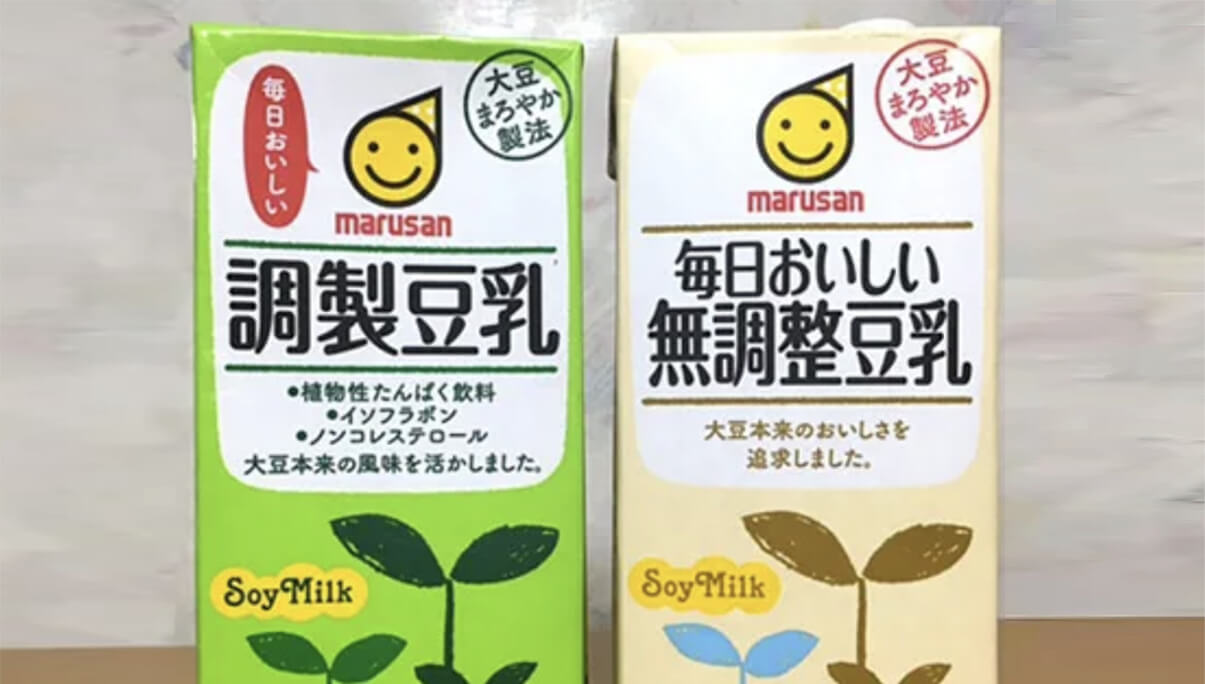
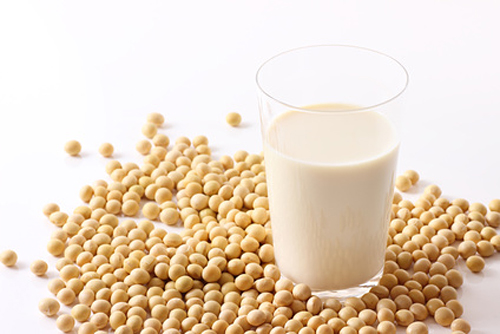
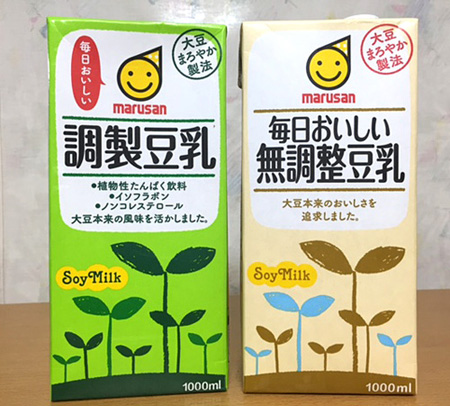
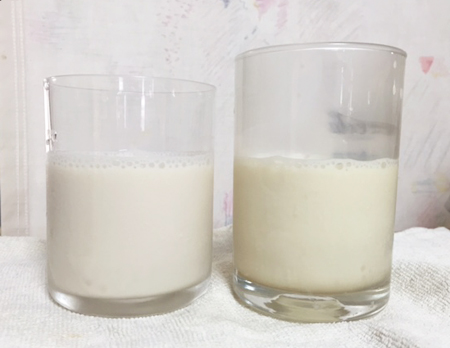
Comments
List of comments (3)
途中から調整と無調整が入れ替わってる。表も。
無調整のほうがドロっとしてるほうで、カロリーも低いはず。
ブログのシステム不良で返信が大変遅くなり申し訳ございませんでした。
当ブログへのご訪問ありがとうございます。
また、記事内容の不備へのご指摘本当にありがとうございました。
その後、改めて2つのメーカー(キッコーマン、マルサン)の、
調製豆乳と無調整豆乳を買って来て
妻と2人で飲み比べをしてみました。
おっしゃる通り、カロリーについては2社とも無調整の方がやや低く、
飲み口については無調整の方がどろっとした感じでした。
また、表の細かい数字も現在の商品とだいぶ違っているので
それも全て修正させていただきました。
ご指摘、心から感謝いたします。ありがとうございました。